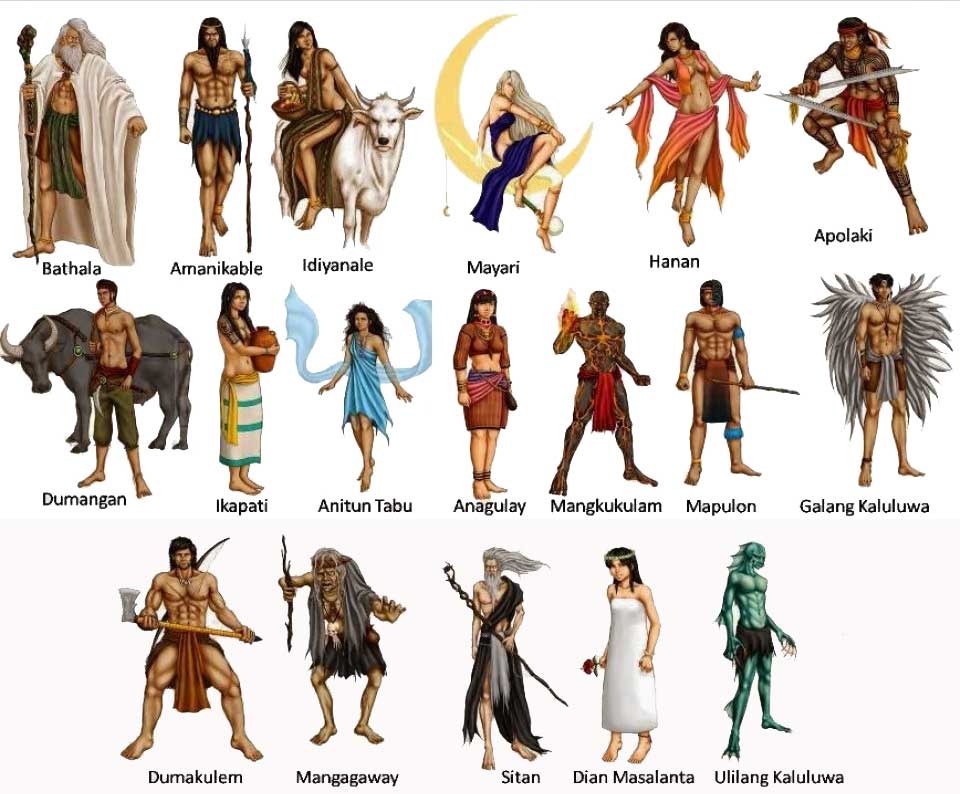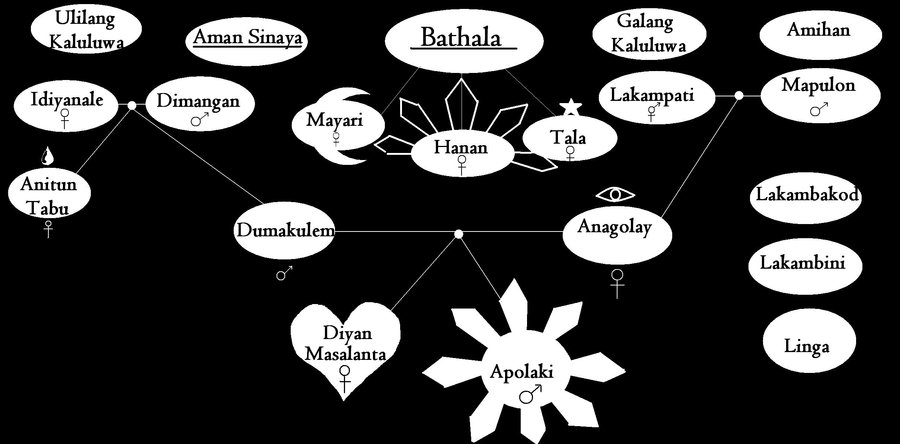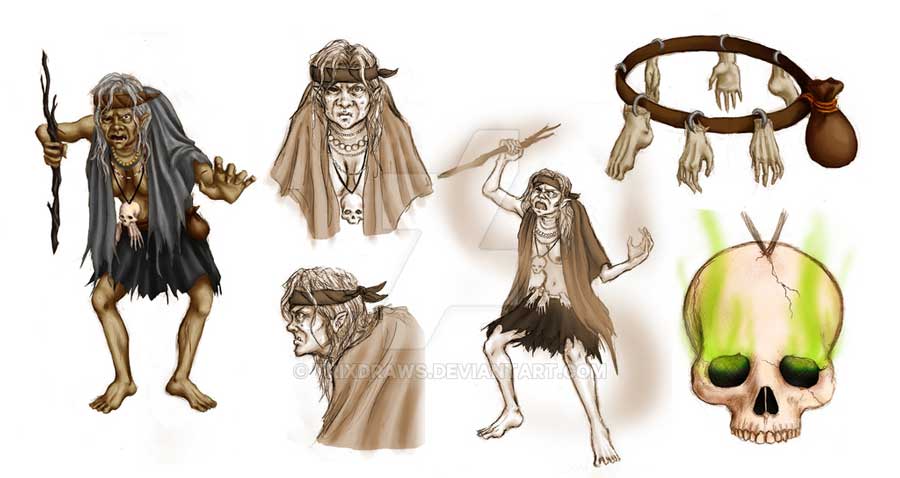The stories of ancient Philippine mythology include deities, creation stories, mythical creatures, and beliefs. Ancient Philippine mythology varies among the many indigenous tribes of the Philippines. Some groups during the pre-Spanish conquest era believed in a single Supreme Being who created the world and everything in it, while others chose to worship a multitude of tree and forest deities (diwatas). Diwatas came from the Sanskrit word devata which means “deity“, one of the several significant Hindu influences in the Pre-Hispanic religion of the ancient Filipinos. Below are some of the gods and goddesses among the Tagalogs of the ancient Philippines:
The Tagalog people are a major ethnic group in the Philippines. They form a majority in Manila, Marinduque and southern Luzon, and a plurality in Central Luzon and the islands of Mindoro, Palawan, and Romblon.
Tagalog Deities in Philippine Mythology
The first part as shown below were the residents of Kaluwalhatian (the Ancient Tagalog Skyworld). The list is divided into generations based on common beliefs about the offspring of the gods.
FIRST GENERATION DEITIES:
Bathala – supreme god and creator deity, also known as Bathala Maykapal, Lumilikha, and Abba; an enormous being with control over thunder, lightning, flood, fire, thunder, and earthquakes; presides over lesser deities and uses spirits to intercede between divinities and mortals; referred by Muslims as Anatala;the tigmamanuquin (tigmamanukan) is attributed to Bathala. [Click here to learn more about Bathala]
Amanikable – Originally this god was worshipped as the god of Hunters. In more modern stories he has become associated as the ill-tempered god of the sea, replacing Aman Sinaya among of the first generation gods (aside from Bathala), he was never married after his love was spurned by a beautiful mortal maiden, Maganda. In frustration, he swore vengeance against the humans by sending turbulent waves and horrible tempests in order to wreck boats and to drown men.
Idiyanale – The goddess of labor and good deeds. Natives used to call for her guidance in order to make their works successful. She married Dimangan and had two offspring.
Dimangan The god of good harvest. He was married to Idiyanale and had two offspring.
Ikapati – (Jocano’s Tagalog Pantheon) The goddess of cultivated land. She was the most understanding and kind among the deities of Bathala. Her gift to man was agriculture. As the benevolent giver of food and prosperity, she was respected and loved by the people. From her came fertility of fields and health of flocks and herds.
Ikapati was said to have married Mapulon, god of seasons. They had a daughter named Anagolay, who became the goddess of lost things. When Anagolay attained maidenhood, she married Dumakulem, son of Idianale and Dumangan, by whom she had two children, Apolake, who became god of the sun and patron of warriors, and Dian Masalanta, who became goddess of lovers.
Lakapati – Often combined with Ikapati from Jocano’s Tagalog pantheon, Lakapati was a major fertility deity. During sacrifices made in a new field, the farmer would hold up a child and say, “Lakapati, pakanin mo yaring alipin mo; huwag mong gutumin [Lakapati, feed this thy slave; let him not hunger]” (San Buenaventura 1613, 361).
Prominent among deities who received full-blown sacrifices were fertility gods. Lakapati, fittingly represented by a hermaphrodite image with both male and female parts, was worshiped in the fields at planting time.
Mapulon – The god of seasons and husband of Ikapati of whom they had a daughter.

SECOND GENERATION DEITIES:
Mayari – The goddess of the moon and one of the three daughters of Bathala by a mortal woman. She was the most charming of all the goddesses. She had two sisters, Tala and Hanan.
Tala – The goddess of the stars; sister of Mayari and Hanan and one of the three daughters of Bathala by a mortal woman.
Hanan – The goddess of morning; sister of Mayari and Tala and one of the three daughters of Bathala by a mortal woman.
Dumakulem – The strong, agile guardian of mountains and the son of Idiyanale and Dimangan. His sister was Anitun Tabu. He later married Anagolay.
Anitun Tabu – The fickle-minded goddess of wind and rain. She was the daughter of Idiyanale and Dimangan and the sister of Dumakulem.
Anagolay – The goddess of lost things and the only offspring of Ikapati and Mapulon. She was married to Dumakulem.
THIRD GENERATION DEITIES:
Apolaki – (Jocano’s Tagalog Pantheon) The god of sun and the chief patron of warriors. He was the son of Anagolay and Dumakulem.
Diyan Masalanta – The goddess of love, conception and childbirth and the protector of lovers. She was the daughter of Anagolay and Dumakulem and youngest of all the deities.

Some variations exist depending on what source material you are referencing. Some of these differences include:
- In some sources, Bathala is the father of Apolaki, aside from Mayari and Tala hence excluding Hanan.
- In some sources, Amanikable is referred as a sea deity of the Manobo tribe.
- In some sources, Idiyanale is identified as the goddess of agriculture.
- In some sources, aside from being a goddess of agriculture, Idiyanale is also identified as the goddess of animal husbandry.
- In some sources, Lakapati is identified as a hermaphrodite and confused with the female deity Ikapati.
- In some creation myth, Mayari is the sister of Apolaki.
- In some sources, Mayari is identified as an one-eyed goddess.
- In some creation myth, Tala is the sister of Mayari and Apolaki and the daughter of Bathala.
- In some creation myth, Apolaki is the brother of Mayari and the son of Bathala.
‘Harmful’ Tagalog Deities in Ancient Philippine Mythology
In Outline of Philippine Mythology, F. Landa Jocano wrote, “The ancient Tagalogs also believed in the final judgment of men—that is, the punishing of the evil and the rewarding of the good. The souls of good men were said to be taken to a village of rest called Maca, which resembled the Christian Paradise, where they enjoyed eternal peace and happiness. However, those who deserved punishment were brought to Kasanaan, the village of grief and affliction where they were tortured forever. These souls were kept there by the chief deity named Sitan.”
I think it is important to say that there may not have ever been a Tagalog deity named Sitan, but instead a class of demons that embodied evil and punishment, called sitan – documented by Juan de Plasencia’s in 1589 “Relation of the Worship of the Tagalogs, Their Gods, and Their Burials and Superstitions”:
“There were also other pagans who confessed more clearly to a hell, which they called, as I have said, casanaan; they said that all the wicked went to that place, and there dwelt the demons, whom they called sitan.”
With such a strong Islamic influence in the Tagalog region, the sitan may have been more like the Arabic zabaniyah – the forces of hell, who torment the sinners, also called the Angels of punishment or Guardians of Hell.
Jocano presents that Sitan was assisted by many mortal agents. The most wicked among them was Mangagauay. She was the one responsible for the occurrence of disease. She was said to possess a necklace of skulls, and her girdle was made up of several severed human hands and feet. Sometimes, she would change herself into a human being and roam about the countryside as a healer. She could induce maladies with her charms.
If she wished to kill someone, she did so by her magic wand. She could also prolong death, even for a number of months, by simply binding to the waist of her patient a live serpent which was believed to be her real self or at least her substance.
The second agent of Sitan was called Manisilat. She was sometimes known as the goddess of broken homes. She was said to be restless and mad whenever there was a happy home within sight. And when she was determined to destroy every such happy home, she would disguise as a woman healer or an old beggar, enter the dwelling of her unsuspecting victims, and then proceed with her diabolical aims. With the aid of her charms and magic powers, she would turn the husband and wife against each other. She was most happy when the couple quarreled and she would dance in glee when one of them would leave the conjugal home.
The third agent of Sitan was known as Mankukulam, whose duty was to emit fire at night, especially when the night was dark and the weather was not good. Like his fellow agents, he often assumed human form and went around the villages pretending to be a priest-doctor. Then he would wallow in the filth beneath the house of his victim and emit fire. If the fire was extinguished immediately, the victim would die.
The fourth such agent was called Hukloban. She had the power to change herself into any form she desired. In fact, some people said that she had greater power than Mangagauay. She could kill anyone by simply raising her hand. However, if she wanted to heal those whom she had made ill by her charms, she could do so without any difficulty. It was also said of her that she could destroy a house by merely saying that she would do so.

Other Tagalog Deities in Philippine Mythology
The list includes the gods and goddesses who don’t have a unified pantheon within the Tagalog deities mentioned above.
Aman Sinaya – Deity of the ocean and protector of fishermen.
Saik, often referred to as Haik (possibly due to a spelling error in a Boxer Codex translation) – the god of the sea who protects travelers from tempests and storms.
Lakambakod – The protector of the growing crops.
Lakambini – is know as the “pure maiden” for his incomparable beauty, ironic that he is a male diwata. He was originally known as the god of “kapurihan”(purity) and is also the god of food, festivity and anti-gluttony. worshiped mainly by men: they pray to Lakambini to let them find a beautiful maiden to wed. An obscure deity called “abogado dela garganta” (throat advocate) by the Spaniards and was turned into the god of gluttony.
Lingga – deity invoked by the sick.
Bathala’s Children and other Deities Documented in Oriental Mindoro c. 1971
These are the names used in the “Origin of the Rainbow” Tagalog myth from Oriental Mindoro
Bathala, supreme being in the heavens.
Tala, the morning star. Bathala’s daughter.
Liwayway, the dawn. Bathala’s daughter.
Tag-ani, the goddess of harvest. Bathala’s daughter.
Bighari, who was the goddess of flowers, loved to play among the flowers in the garden. Bathala’s daughter.
Kidlat, the lightning. Bathala’s son.
Hangin, the wind. Bathala’s son.
Araw, the sun. Bathala’s son.
Panginoon, the messenger of Bathala.
NAMES OF DEITIES IN SANTO TOMAS LAGUNA
Several deities are mentioned in the paper of Archbishop of Manila, Felipe Pardo (1688) about idolatries in the town Santo-Thomas of municipalities, Laguna. Although the names of many had already been forgotten by the witnesses, the number of those still remembered is nevertheless impressive. Most are absent from the other sources at our disposal.
► = comes from
Span. = Spanish spelling
Anatála = the Supreme God Mal. Alataala “God” Ar. Ji l [“alla:h tafa:la:]
“God, be He exalted.”
Alagaka ► Span. Alagaca = protector of hunters
Balakbák at Balantáy Span. Balacbac y Balantay= the two guardians of Tanguban, the abode of the souls of the dead.
Bingsól ► Span. Bingsol = the god of ploughmen
Biso [Bisô “Holeless-Eared”] Span. Biso = the police officer of heaven
Búlak Pandán ►Span. Bulac-pandan =”cotton (flower?) of pandanus”
Búlak Tálà ► Span. Bulactala= the deity of the Morning Star / the planet Venus seen at dawn (N&S 1860:3 16) (p. 128) Sans. tārá aR = a fixed star (MW 443).
Dalágañg nása Buwán = the Maiden in the Moon
Dalága ►Ginúong Dalága ► Span. Guinoo Dalaga = “Lady Maiden”, the goddess of crops.
Dalágañg Binúbúkot = the Cloistered Maiden (in the Moon)
Gánay ► Ginúoñg Gánay Span. Guinoong Ganay = “Lady Old Maid”
Hasanggán ►Span. Hasangan = a terrible god
Kampungán ► Maginúoñg Kampungán ► Campongan = Lord Supporter”: a god of harvests and sown fields
Kapiso Pabalítà ► Span. Capiso pabalita = “News-giving”, protector of travelers
Lakapátì ► Span. Lacapati = the god of vagrants and waifs
Lampinsákà “cripple” ► Span. Lampinsaca= the god of the lame and the cripple
Makapúlaw ► Span. Macapulao = “Watcher” the god of sailors
Makatalubháy ► Span. Macatalubhay = the god of bananas.
Matandâ ► Siyák Matandâ ► Span. Siac Matanda = “Old Sheikh”: the god of merchants and second-hand dealers.
Ang Maygawâ ► Span. Ang Maygawa = The Owner of the Work.
Paalúlong ► Span. Paalolong = “Barker”, the god of the sick and the dead
Paglingniyalán [?]► Span. Paglingñalan = the god of hunters
Pagsuután ► Ginúoñg Pagsuután ► Span. Guinoong pagsohotan = Clothing Lady”, protectress of women in travail.
Pagwaagán ► Span. Pagvaagan = the god of winds.
Panáy ► Ginúoñg Panáy “Lord/Lady Panay” = deity residing in a kalumpáng tree (Sterculia tree Span. La Campinay = foetida), although panay is either (Syzygium) or tuffy (cooked honey).
Pinay ► Lákañg Pinay ► Span. La Campinay “Her Lordship the old midwife Pinay”
Púsod-Lúpà ► Span. Posor Lupa = “Earth Navel”, a god of the fields
Sirit ► Span. Cirit / Zirit [Sírit “Snake’s Hiss”) =a servant of the gods
Sungmásandál ► Maginúoñg Sungmásandál [Sumásandál The one that keeps close”] ► Span. Maguinoong Sungmasandal
Jordan Clark is a Canadian born descendant of Scottish immigrants living on the homelands of the Lekwungen speaking peoples. His interest in Philippine myth and folklore began in 2004. Finding it difficult to track down resources on the topic, he founded The Aswang Project in 2006. Shortly after, he embarked on a 5 year journey, along with producing partner Cheryl Anne del Rosario, to make the 2011 feature length documentary THE ASWANG PHENOMENON – an exploration of the aswang myth and its effects on Philippine society. In 2015 he directed “The Creatures of Philippine Mythology” web-series, which features 3 folkloric beings from the Philippines – the TIKBALANG, KAPRE and BAKUNAWA. Episodes are available to watch on YouTube. Jordan recently oversaw the editing for the English language release of Ferdinand Blumentritt’s DICCIONARIO MITOLÓGICO DE FILIPINAS (Dictionary of Philippine Mythology) and is working on two more releases with fellow creators scheduled for release later this year. When his nose isn’t in a book, he spends time with his amazing Filipina wife of 20 years and their smart and wonderful teenaged daughter.


